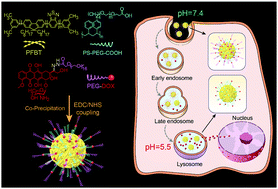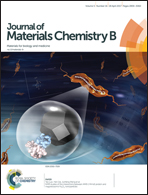Facilely synthesized pH-responsive fluorescent polymer dots entrapping doped and coupled doxorubicin for nucleus-targeted chemotherapy†
Abstract
Doxorubicin (Dox) functionalization methods can affect the Dox loading efficiency and release capability in nanosized drug delivery systems. Herein, different Dox-functionalized (doping, coupling, and doping and coupling) fluorescent poly(9,9-dioctylfluorene-alt-benzothiadiazole) (PFBT) polymer dots were designed and their application performance was evaluated. Polyethylene glycol-modified doxorubicin (PEG-Dox) was synthesized using a responsive hydrazone linker. PEG-DOX-doped polymer dots were self-assembled using a co-precipitation method and free PEG-Dox was further coupled on the surface of the polymer dots via an EDC–NHS coupling to prepare the PEG-Dox doped and coupled PFBT polymer dots. The hydrazone linker of PEG-Dox is responsive to the acidic environment, resulting in the doped Dox being released into the cell nucleus and the coupled Dox changes the structure of the polymer dots and accelerates the release of the doped Dox. Moreover, the coupled Dox linked via an amide bond was still on the surface of the polymer dots and retained their cytoplasmic toxicity for a synergistic effect. A high Dox carrying efficiency (weight of the loaded Dox/weight of PFBT) was achieved using the PEG-Dox doped and coupled PFBT polymer dots: 107% and 82% of Dox was released in vitro within 24 h at pH 5.5. The cytotoxicity and cell imaging were investigated in three cancer cell lines: cervical cancer cells (HeLa), lung cancer cells (NCI-H292), and glioma cells (U87-MG); the results indicate that the PEG-Dox doped and coupled PFBT polymer dots show a distinct killing efficacy and nucleus targeted capability. Moreover, in vivo tumor suppression was observed in lung tumor-bearing mice over 20 days and no weight loss and damage or inflammation of the major organs were detected using the PEG-Dox doped and coupled PFBT polymer dots.



 Please wait while we load your content...
Please wait while we load your content...